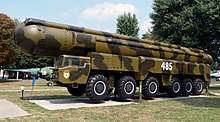
Back أوكرانيا والسلاح النووي Arabic Ukraynada nüvə silahı Azerbaijani Ядзерная зброя Украіны Byelorussian Jaderné zbraně na Ukrajině Czech اوکراین و سلاحهای هستهای Persian Armes de destruction massive en Ukraine French נשק להשמדה המונית של אוקראינה HE Nuklearno naoružanje Ukrajine Croatian Branduoliniai ginklai Ukrainoje Lithuanian Ядерное оружие на Украине Russian



Ukraine, formerly a republic of the Union of Soviet Socialist Republics (USSR) from 1922–1991, once hosted Soviet nuclear weapons and delivery systems on its territory.[1] The former Soviet Union had its nuclear program expanded to only four of its republics: Belarus, Kazakhstan, Russia, and Ukraine. After its dissolution in 1991, Ukraine became the third largest nuclear power in the world and held about one third of the former Soviet nuclear weapons, delivery system, and significant knowledge of its design and production.[2] Ukraine inherited about 130 UR-100N intercontinental ballistic missiles (ICBM) with six warheads each, 46 RT-23 Molodets ICBMs with ten warheads apiece, as well as 33 heavy bombers, totaling approximately 1,700 nuclear warheads that remained on Ukrainian territory.[3]
While all these weapons were located on Ukrainian territory, Russia controlled the launch sequence and maintained operational control of the nuclear warheads and its weapons system.[4] In 1994, Ukraine agreed to transfer these weapons to Russia and became a party to the Treaty on the Non-Proliferation of Nuclear Weapons, in exchange for assurances from Russia, the United States and United Kingdom to respect the Ukrainian independence and sovereignty in the existing borders.[5][6] The decision by Ukraine to give up the nuclear weapons was debated when Russia, one of the parties of the agreement, invaded Ukraine.
- ^ Nohlen, D & Stöver, P (2010) Elections in Europe: A data handbook, p1976 ISBN 9783832956097
- ^ Dahlburg, Decemb. "Ukraine Votes to Quit Soviet Union : Independence: More than 90% of Voters Approve Historic Break with Kremlin. The President-elect Calls for Collective Command of the Country's Nuclear Arsenal". LA Times. Retrieved April 15, 2014.
- ^ Norris, Robert S. (January–February 1992). "The Soviet Nuclear Archipelago". Arms Control Today. 22 (1). Arms Control Association: 24–31. JSTOR 23624674.
- ^ Hanley, Jeremy (June 22, 1993). "Nuclear Weapons". Hansard. UK Parliament. Column 154. Retrieved September 9, 2018.
The Minister of State for the Armed Forces (Mr. Jeremy Hanley): ... Some weapons are also possessed by Ukraine, Kazakhstan and Belarus, but these are controlled by the Commonwealth of Independent States.
- ^ William C. Martel (1998). "Why Ukraine gave up nuclear weapons : nonproliferation incentives and disincentives". In Barry R. Schneider, William L. Dowdy (ed.). Pulling Back from the Nuclear Brink: Reducing and Countering Nuclear Threats. Psychology Press. pp. 88–104. ISBN 9780714648569. Retrieved August 6, 2014.
There are some reports that Ukraine had established effective custody, but not operational control, of the cruise missiles and gravity bombs. ... By early 1994 the only barrier to Ukraine's ability to exercise full operational control over the nuclear weapons on missiles and bombers deployed on its soil was its inability to circumvent Russian permissive action links (PALs).
- ^ Alexander A. Pikayev (Spring–Summer 1994). "Post-Soviet Russia and Ukraine: Who can push the Button?" (PDF). The Nonproliferation Review. 1 (3): 31–46. doi:10.1080/10736709408436550. Archived from the original (PDF) on August 8, 2014.
